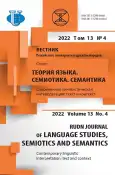Лингвокультурные коннотации лексемы ИВА в русском и китайском языках
- Авторы: Сунь Ю.1, Рыбаков М.А.1, Лысякова М.В.1
-
Учреждения:
- Российский университет дружбы народов
- Выпуск: Том 13, № 4 (2022): СОВРЕМЕННАЯ ЛИНГВИСТИЧЕСКАЯ ИНТЕРПРЕТАЦИЯ: ТЕКСТ И КОНТЕКСТ
- Страницы: 1094-1109
- Раздел: СЕМИОТИКА И ИССЛЕДОВАНИЯ ХУДОЖЕСТВЕННОГО ТЕКСТА
- URL: https://journal-vniispk.ru/2313-2299/article/view/323475
- DOI: https://doi.org/10.22363/2313-2299-2022-13-4-1094-1109
- ID: 323475
Цитировать
Полный текст
Аннотация
Предлагается обзор лингвокультурных коннотаций фитономена ИВА через анализ результатов процесса восприятия данного объекта окружающего мира и эстетических представлений о нем носителей русского и китайского языка. Актуальность исследования обусловлена потребностью точного понимания и передачи полученной информации при коммуникации представителей разных культур, а также недостаточной изученностью лингвокультурных коннотаций фитономена в русском и китайском языках, в особенности в сопоставительном аспекте. Цель работы - изучение коннотаций лексемы ИВА в русской и китайской лингвокультурах. Материалом исследования является фитономен ИВА с особыми лингвокультурными коннотациями в сознании россиян и китайцев. Методы исследования: дескриптивный, контекстуальный, сопоставительный, компонентного анализа, когнитивного моделирования. Исследование принадлежит сфере интересов актуального направления в языкознании - сопоставительной лингвокультурологии. Научная новизна предпринятого анализа состоит в уточнении историко-культурных ассоциативных значений лексемы ИВА в русской и китайской лингвокультурах. Результатом исследования стало установление того факта, что ива занимает высокое положение в обеих лингвокультурах, тесно связана с мотивами «спасения» в русской и рассматривается как священное дерево в китайской. Ива символизирует весну, жизнь и грациозный женский образ в двух языках. Кроме того, она еще олицетворяет скорбь, горе и даже похороны в русской лингвокультуре, а в китайской ива обладает коннотациями «легкомысленная девушка», «расставание», «тоска по кому-нибудь отсутствующему или по родине». Отсюда вытекает заключение о том, что лингвокультурные коннотации лексемы ИВА в русском и китайском языках не полностью совпадают, они имеют как сходства, так и различия.
Ключевые слова
Об авторах
Юйно Сунь
Российский университет дружбы народов
Автор, ответственный за переписку.
Email: 876136269@qq.com
ORCID iD: 0000-0002-0854-6097
аспирант по направлению 45.06.01 Языкознание и литературоведение кафедры общего и русского языкознания филологического факультета
117198, Российская Федерация, г. Москва, Миклухо-Маклая, д. 6Михаил Анатольевич Рыбаков
Российский университет дружбы народов
Email: rybakov-ma@rudn.ru
ORCID iD: 0000-0001-9444-3889
кандидат филологических наук, доцент, доцент кафедры общего и русского языкознания филологического факультета
117198, Российская Федерация, г. Москва, Миклухо-Маклая, д. 6Марина Витальевна Лысякова
Российский университет дружбы народов
Email: lysyakova-mv@rudn.ru
ORCID iD: 0000-0002-2592-6067
кандидат филологических наук, доцент, доцент кафедры общего и русского языкознания филологического факультета
117198, Российская Федерация, г. Москва, Миклухо-Маклая, д. 6Список литературы
- Russian Encyclopedic Dictionary (2000). In 2 vols, A.M. Prokhorov (Ed.). Moscow. (In Russ.).
- Soviet Encyclopedic Dictionary (1983). A.M. Prokhorov (Ed.). Moscow. (In Russ.).
- Big encyclopedic dictionary (1999). Moscow: Great Russian Encyclopedia; St. Petersburg: Norint. (In Russ.).
- Elmslev, L. (2006). Prolegomena to the theory of language. Moscow: KomKniga. (In Russ.).
- Postmodernism. Encyclopedia. (2001). Minsk: Interpressservice; Book House. (In Russ.).
- Naida, E.A. (1962). Analysis of the meaning and compilation of dictionaries. New in linguistics. Iss. 2. Moscow: Inostrannaya literatura. pp. 45–71. (In Russ.).
- Goverdovsky, V.I. (1979). History of the concept of connotation, 2, 83–86. (In Russ.).
- Rakitina, O.N. (2008). Valuable Aspect of German and Russian Names of Landscape Elements as Segments of Linguistic Worldview. Language. Culture. Communication. Proceedings of the 2nd International Scientific Conference, Volgograd, May 14–15. In 2 parts. Part 1. Volgograd: Izd-vo VolGU. pp. 216–221. (In Russ.).
- Chulkina, N.L. & Koltsova, N.V. (2017). Conflictogenety level of the conceptual field “wealth / poverty” in the linguistic conciousness of russians and the Chinese. RUDN Journal of Language Studies, Semiotics and Semantics, 8(4), 1178–1190. https://doi.org/10.22363/2313-22992017-8-4-1178-1190 (In Russ.).
- Koval, V.I. (2020). Symbol of Mouse in Slavonic and Chinese Linguocultures. RUDN Journal of Language Studies, Semiotics and Semantics, 11(2), 250–264. https://doi.org/10.22363/23132299-2020-11-2-250-264 (In Russ.).
- Wu, P. (2018). The semantics of yellow color terms in Chinese and Russian linguocultures. RUDN Journal of Language Studies, Semiotics and Semantics, 9(3), 729–746. https://doi.org/10.22363/2313-2299-2018-9-3-729-746 (In Russ.).
- Big encyclopedic dictionary. URL: https://gufo.me/dict/bes/%D0%98%D0%92%D0%90. (accessed: 6.03.2021). (In Russ.).
- Blidari, E. Beautiful willow. URL: https://www.realrocks.ru/evghenii/92816. (accessed: 6.03.2021). (In Russ.).
- Fet, A.A. Willows and birches. URL: http://stih.su/ivy-i-berezy/ (accessed: 6.03.2021). (In Russ.).
- Tsvetaeva, M.I. Bonapartists. URL: https://www.culture.ru/poems/34708/bonapartisty. (accessed: 6.03.2021). (In Russ.).
- Nekrasov, N.A. The funeral. URL: http://nekrasov-lit.ru/nekrasov/stihi/256.htm. (accessed: 6.03.2021). (In Russ.).
- Gippius, Z.N. Female “No”. URL: https://www.culture.ru/poems/26764/zhenskoe-netu. (accessed: 6.03.2021). (In Russ.).
- Guo, R. & Yang, H. (2020). Comparison of the symbolic meanings of willow in Russian and Chinese cultures. Economy and culture in border areas, 6, 34–38. (In Chinese). / 郭荣荣, 杨海云. 俄汉文化中柳的象征意义对比. 边疆经济与文化, 2020, 6, 34–38.
- Shi, Z. (2007). Study of the theme and image of willow in ancient Chinese literature [dissertation]. Nankin. (In Chinese). 石志鸟. 中国古代文学杨柳题材与意象研究. 南京师范大学.
- Han, F. (2009). Encyclopedia of Han Feizi. Beijing: Chang’an. (In Chinese). 韩非. 韩非子全 书. 内蒙古: 内蒙古人民出版社.
- He, Z. Praising the willow. URL: https://baike.baidu.com/item/%E5%92%8F%E6%9F%B3/172 (accessed: 6.03.2021). (In Chinese).
- Wang, W. Rural fun. URL: https://baike.baidu.com/item/%E7%94%B0%E5%9B%AD%E4%B9%90%E4%B8%83%E9%A6%96/1734294?fromtitle=%E7%94%B0%E5%9B%AD%E4%B9%90&fromid=10391610 (accessed: 6.03.2021). (In Chinese).
- Meng, Q. (2014). Poems of plot content. Shanghai: Chinese Book Press. (In Chinese). 孟棨. 本事诗. 上海:中华书局.
- Bai, J. A song of endless sorrow. URL: https://baike.baidu.com/item/%E9%95%BF%E6%81%A8%E6%AD%8C/22524 (accessed: 6.03.2021). (In Chinese).
- Liu, Y. Household folk poetry. URL: https://baike.baidu.com/item/%E7%AB%B9%E6%9E%9D%E8%AF%8D%E4%BA%8C%E9%A6%96/2877635?fromtitle=%E7%AB%B9%E6%9E%9D%E8%AF%8D%C2%B7%E6%9D%A8%E6%9F%B3%E9%9D%92%E9%9D%92%E6%B1%9F%E6%B0%B4%E5%B9%B3&fromid=3000814 (accessed: 6.03.2021). (In Chinese).
- Li, Q. Schizanutus. URL: https://baike.baidu.com/item/%E8%9D%B6%E6%81%8B%E8%8A%B1%C2%B7%E6%9A%96%E9%9B%A8%E6%99%B4%E9%A3%8E%E5%88%9D%E7%A0 %B4%E5%86%BB (accessed: 6.03.2021). (In Chinese).
- Cao, X. & Gao, E. (2006). Dream in the Red Chamber. Shanghai: Shanghai Ancient Book Press. Vol. 4. (In Chinese). 曹雪芹, 高鹗. 红楼梦. 全四册. 上海: 上海古籍出版社, 2006. 第4册.
- Wang, W. Seeing me friend Yuan’er off to Anxi. URL: https://baike.baidu.com/item/%E9%80%81%E5%85%83%E4%BA%8C%E4%BD%BF%E5%AE%89%E8%A5%BF/2802011?fromtitle=%E6%B8%AD%E5%9F%8E%E6%9B%B2&fromid=3884 (accessed: 6.03.2021). (In Chinese).
- Wang, J. & Dong, N. (2014). Collection of Wang Wei. Jiangsu: Phoenix. (In Chinese). 王继洪, 董乃斌. 王维集. 江苏: 凤凰出版社.
- Ban, G. (2018). The general principle of Baihu. Beijing: Chinese Book Press. (In Chinese). 班 固. 白虎通义. 北京: 中国书店出版社.
- 李白. 春夜洛城闻笛. https://so.gushiwen.cn/mingju/juv_d26a6d8d3f1b.aspx (访问日期: 2022年3月6日) Li, Bai. Hear the pipe on a spring evening in Luoyang. URL: https://so.gushiwen.cn/mingju/ juv_d26a6d8d3f1b.aspx (accessed: 6.03.2022). (In Chinese).
- 冯贽. 云仙杂记. 北京:商务印书馆, 1934. Feng, Zhi. (1934). Yunxian’s sketch. Beijing: Commercial Press. (In Chinese).
- 惠富平. 齐民要术. 北京: 科学出版社, 2019. Hui, Fuping. (2019). Crafts needed by people. Beijing: Science Press. (In Chinese).
Дополнительные файлы









